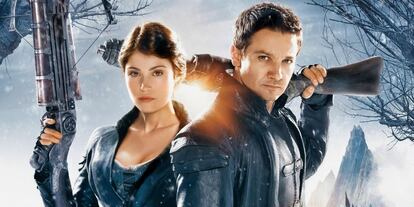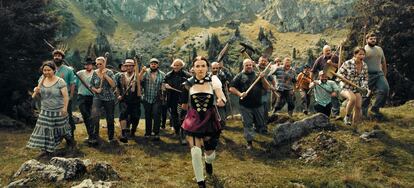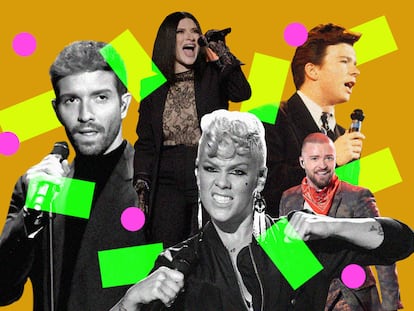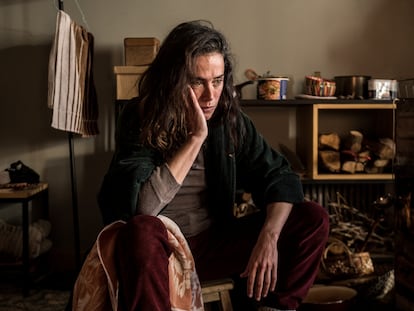A Nazi-killing Heidi and a serial-killing Winnie the Pooh: Why have children’s classics become ultra-violent?
The release of classics into the public domain has prompted the subversive trend of making children’s storybook characters terrifying

A couple frolic naked in an idyllic spot in the Alps. The woman asks the man to stay a little longer, but he says no: “Goats need love too. They don’t call me Peter the Goatherd for nothing.” The scene, which looks like a porn version of Heidi, is really the introduction to the movie Mad Heidi, a take on the children’s classic with the endearing Alpine orphan now an anti-fascist guerrilla who stands up to the totalitarian Swiss regime that revolves around the cheese monopoly, cheese that Peter is secretly trafficking.
A grindhouse-style movie, Mad Heidi is a story of revenge that sits halfway between Quentin Tarantino’s Kill Bill and Inglourious Basterds, where Miss Rottenmeier is unsurprisingly recast as running a concentration camp and Clara loses her legs in a fight.

Produced in Switzerland and made on a €3 million budget through crowdfunding, the film will also be released this week in Germany, Austria and France. The villain of the piece, a dictator who exterminates lactose intolerant people who are seen to be betraying the Swiss homeland, is played by Casper van Dien, the star of the cult film Starship Troopers: The Space Brigades (1997). The movie brings to mind Our Robocop Remake (2014), a send-up of the 1980s classic.
That film was distributed as a not-for-profit venture because it did not have the rights to the character. In the case of Mad Heidi, the adaptation can be commercialized because it does not reference the Japanese-style animated version, but rather the original 19th century book by the Swiss author Johanna Spyri, which is now in the public domain.
For the same reason, Winnie the Pooh: Blood and Honey, a horror movie to be released in 2023, in which the Hundred Acre Wood’s bear turns psychopathic killer due to neglect from Christopher Robin. The general public will remember Winnie the Pooh from the Disney cartoons and the stories written in 1926 by A.A. Milne. The original classic moved into the public domain in January this year.

Piglet, Pooh’s friend, will also appear in the movie, though not other characters such as Tigger, which are still under exclusive license for Disney, having been developed years later. The new adaptation is inspired by the original model and cannot be reminiscent in characterization or dialogue of Disney’s version. This is similar to the case of Mickey Mouse, whose entry into the US public domain is scheduled for 2024, though this does not mean that it can be reproduced in any way one sees fit, but rather exclusively from the original black and white Steamboat Willie image from 1928 – and without using the name, which remains a registered trademark.
Horror variants of children’s classics are a whole subgenre. In the last decade, for example, up to six adult feature films have been produced based on Hansel and Gretel, the tale the Brothers Grimm published in 1812, including the bloody Hansel and Gretel: Witch Hunters (2013), produced by comedian Will Ferrell and made by the director of Nazi Zombies, and Gretel and Hansel: A Grim Fairy Tale (2020), a serious horror movie that enjoyed a certain cult following thanks to the boost it got from streaming during lockdown.
The American slasher movie Pinocchio’s Revenge (1996) – what seemed to be a reaction to the sugar-coated version of the tale by Disney in 1940 – justified its existence with the argument that in the original published by the Italian Carlo Collodi in the 1880s, Pinocchio was not all good. Among other things, he murdered the cricket – his conscience – as soon as he met him.
Latent fears
But María Victoria Sotomayor, professor of Spanish Literature and Children’s Literature at Madrid’s Autonomous University of Madrid, has reservations regarding the argument that these films simply highlight the original elements of terror that were eliminated or distorted by Disney. “I don’t think the spirit of these tales was to terrify,” she says. “In general, folk tales from an anonymous author and originating from the most primitive oral tradition, were not created just for children but for everyone. Naturally, life is full of danger, problems, joys and fears, encounters and misunderstandings, friends and enemies, and what is being represented here is an exaggeration of the negative, difficult or conflictive content, when I believe its true function is to offer a lesson in how to face and overcome that.”

Sotomayor dismisses the idea that Hansel and Gretel or Pinocchio sought to dissuade children from leaving home by exposing them to the disturbing threats in the outside world, such as the witch who wants to cook the siblings in Hansel and Gretel or the moment Pinocchio is turned into a donkey when he runs away. “Hansel and Gretel do not abandon their home; it is their parents who abandon them in the forest. And Pinocchio is also a fable that goes far beyond warning children of dangers. According to many interpretations, Pinocchio is a faithful representation of a flawed human being – contradictory and weak, but also good and noble, who stumbles towards maturity. As we all do.”
Netflix will release a new animated version of Pinocchio next December, directed by Guillermo del Toro and Mark Gustafson. Not strictly horror, this adaptation is nevertheless faithful to Del Toro’s fantastic imagination, with Gepetto as a sort of tragic Dr. Frankenstein overwhelmed by his creation. Also, a co-writer of the screenplay, Del Toro places the story within the context of Mussolini’s fascist Italy, which lends new meaning to the theme of obedience.
Although, Mad Heidi and Winnie the Pooh: Blood and Honey are spoofs, they still bring to mind terror motifs such as the invisible friend that accompanies virtually every child in a horror movie, and that invariably turns out to be a ghost or a demon; or other typical terror props, such as the clown from It or the porcelain doll Annabelle from The Conjuring Universe.

“There might be a certain awareness that childhood fears form part of the fears that stay with us into adulthood and, also, the new stories that we forge in a cultural system that questions and conditions us,” says Sotomayor. “Childhood is the origin of everything: of fear, of life and of one’s own personal identity. It is logical to return to it.” Sotomayor then quotes the writer H.P. Lovecraft: “Of all human emotions, the oldest and most powerful is fear, and of all fears, the oldest and most powerful is the fear of the unknown.”
If Winnie the Pooh: Blood and Honey is successful when it’s released, director Rhys Frake-Waterfield has said he would create a cinematic universe based on fairy tales. The next on the list is Peter Pan: Neverland Nightmare, as J.M. Barrie’s story is also about to move into the public domain.
Tu suscripción se está usando en otro dispositivo
¿Quieres añadir otro usuario a tu suscripción?
Si continúas leyendo en este dispositivo, no se podrá leer en el otro.
FlechaTu suscripción se está usando en otro dispositivo y solo puedes acceder a EL PAÍS desde un dispositivo a la vez.
Si quieres compartir tu cuenta, cambia tu suscripción a la modalidad Premium, así podrás añadir otro usuario. Cada uno accederá con su propia cuenta de email, lo que os permitirá personalizar vuestra experiencia en EL PAÍS.
¿Tienes una suscripción de empresa? Accede aquí para contratar más cuentas.
En el caso de no saber quién está usando tu cuenta, te recomendamos cambiar tu contraseña aquí.
Si decides continuar compartiendo tu cuenta, este mensaje se mostrará en tu dispositivo y en el de la otra persona que está usando tu cuenta de forma indefinida, afectando a tu experiencia de lectura. Puedes consultar aquí los términos y condiciones de la suscripción digital.
More information
Archived In
Últimas noticias
Most viewed
- Sinaloa Cartel war is taking its toll on Los Chapitos
- Oona Chaplin: ‘I told James Cameron that I was living in a treehouse and starting a permaculture project with a friend’
- Reinhard Genzel, Nobel laureate in physics: ‘One-minute videos will never give you the truth’
- Why the price of coffee has skyrocketed: from Brazilian plantations to specialty coffee houses
- Silver prices are going crazy: This is what’s fueling the rally











































